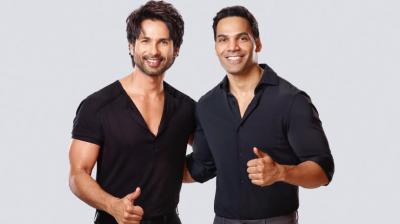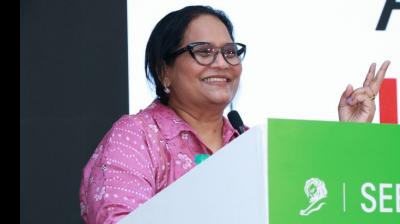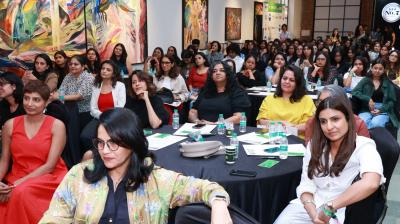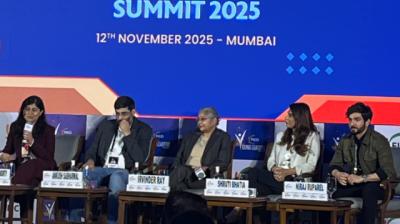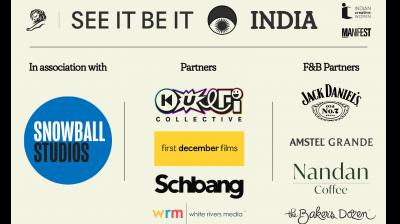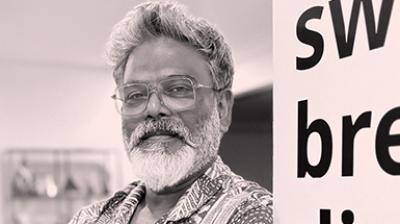As brands strive to stay ahead in an increasingly competitive market, the role of strategic branding and design has never been more crucial.
Acknowledging this, Landor, recently appointed Geet Nazir as its managing director in India as it looked to up its game in the market.
Nazir joined Landor three months ago from Conran Design Group.
We caught up with her to discuss the strategic role of branding, her goals at the agency, design thinking beyond marketing departments, challenges and trends in the space and more...
Edited excerpts:
It's been three months since you joined Landor. What were your targets set?
It’s been a terrific journey. Landor India has been a partner to some terrific clients across the board. We are fortunate to partner with them to build their brand solutions. As we grow, the vision and the goal is to continue the journey of growth, by growing our clients and unlocking new visions and ambitions for their businesses.
Our vision is to ensure that we build great foundations for the clients.
On design in particular - how has its role evolved in shaping business strategy for Indian brands over the last decade?
Branding and design is a very powerful tool to bring business strategy to life. A well-expressed brand allows for a business to connect in a manner that is memorable, differentiated and very, very relevant in building business preference. The evolution of a brand moving more upstream as a business tool rather than a design moving to a downstream aesthetic.
Is design a priority for a marketer?
There’s a range. It depends on where a business is in its lifecycle, and the ambition for growth for a particular business. Branding and design are not just something a marketer needs to look at, it should start in the boardroom because that is how one can create a linkage back to strategy and a business’ ambition.
For instance, a well-designed corporate brand can become a north star of an organisation. It can bring employees together and create a vision for the organisation. It is not only the consumers that experience one’s brand, it’s every single journey of stakeholders that also experience it. Therefore, it’s not just marketers, it’s across the board that one sees the impact of a well-designed brand.
How is Landor India balancing global expertise with local relevance in its approach to branding and design innovation?
The global expertise is the frameworks, experience and benchmarks that we bring to our clients in India. It helps us shape world-ready brands. India, today is not operating in a side. It’s a very different market, but it’s a booming market. Indian brands and clients also have the ambition to be global and world-class in the way that they operate and connect with their audiences, whether here or internationally. This allows us to bring our global advantage to the country.
We understand the nuances of the Indian market. Anything we build has an amount of flexibility and versatility built into it, so that the strong foundations of a brand remain solid as it amplifies in different parts of the country across different product ranges to different types of audiences and value ranges. The way that we allow this flexibility is what ensures that a brand becomes valuable and not vulnerable. The minute you take a brand out to various audiences, there is the temptation to tailor make.
But, with our versatile assets for branding, we provide the space for flexibility while building on a solid or foundational narrative that doesn't change. When clients want to amplify the narrative is where our branding systems come into play. It's a system-based thought process where guidelines then become gold.
What are the common challenges faced?
One is about activating the brand correctly so that the brand experiences that breakthrough in a manner that is intended by the business. And then ensuring that it all comes together in a manner that is true to a single foundation or core.
We understand that in today’s day and age AI is an area where clients want to explore and how it can help them. It is now about ensuring that we use some of these tools in a manner that doesn’t dilute the brand. We have to be certain that any asset we create for the brand augments its journey. We have a versatile branding system where we take the brand's sacred essence and unlock it. It’s not about repeating a logo consistently from place to place, but about bringing these assets to life in a way that is meaningful and relevant in the moment that people experience the brand. This becomes more important now as there are so many frontiers for which a brand has to thrive. It’s not one channel but a chaotic 360-degree one because consumers don’t have a linear journey. It is about taking the sacred assets of the brand and bringing them to life which helps connect with the audiences.
With sustainability and inclusivity becoming non-negotiables, what trends do you foresee taking over the design industry in the coming years?
I think inclusivity and sustainability are built into the DNA of a brand and are not just trends. We must move beyond that aspect of climbing trends, and be able to evoke an emotion or a feeling. One can easily put a dollar value on it. That’s the job.
Where do you think the design industry is heading?
The future is already here. Branding and design have to be responsive. Take a legacy brand, for instance, how does a legacy brand or design unlock itself for trends of the future? It is about understanding that a consumer is moving in a non-linear fashion. How do we design for this evolving world? How do we create a library of assets that arm a brand custodian to go out there and effectively differentiate and communicate themselves? Those are all considerations that a designer brings to the table today. A designer is an equal parts custodian of a brand’s progress.
Digital-first design is not a trend, it’s here to stay. It’s baked into everything that we do. Creating guidelines that can be used as gold by the brand custodian and ensuring that we are future-proofing brands by giving that foundation that is fixed, but allowing for flexibility to grow, is the future of design. It’s not about the colour of the year, it’s much more foundational. And that’s what we think about when we look at a client that needs to evolve or launch.
The future of design is designing for experience. It’s multi-sensorial. It is about creating a brand experience that touches one wherever they are. A designer or brand custodian should think about the level of flexibility to bring in, it can be a local nuance or a feeling. It is about creating a brand across the senses.





